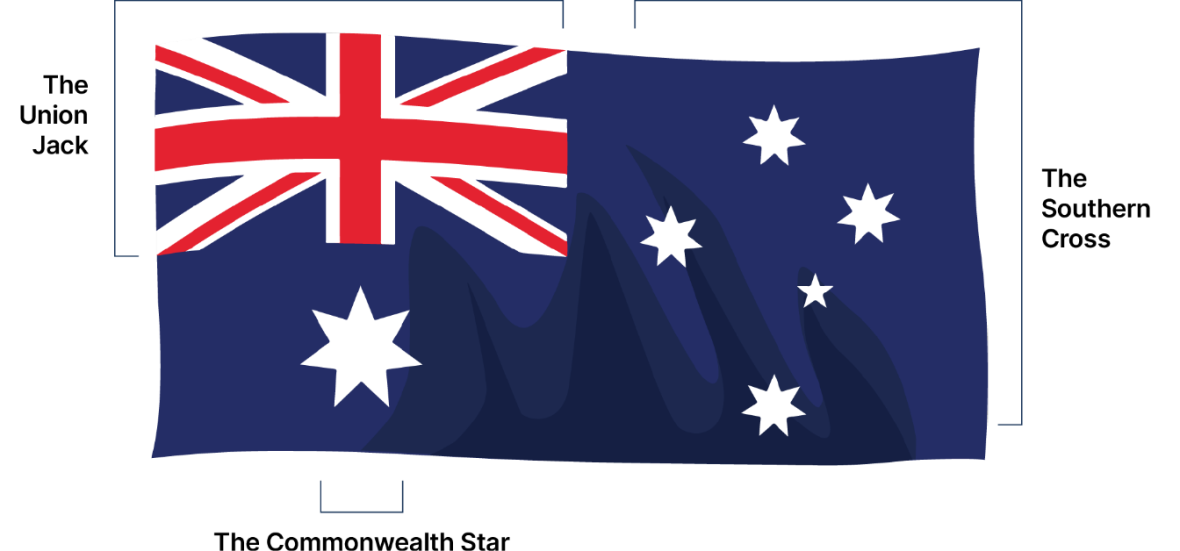A radiant star group helped early sailors find their way to Australia as they voyaged for many months from Europe. Known as the Southern Cross, its 5 stars were useful night-time companions to the settlers and explorers. It became one of the first symbols of the Great South Land. When sailors explored the east coast of Australia in HMS Endeavour, they used the Southern Cross and the nearby brilliant pointer stars Alpha and Beta Centauri to find the south celestial pole, as navigators and bushmen still do today.
First Nations peoples formed images with the stars. Some saw the Southern Cross as the footprint of a giant wedge-tailed eagle, with the pointer stars as a throwing stick used to hunt it. The stars of the Southern Cross were also known to the ancient Greeks, who regarded them as part of the Centaurus constellation. In 1516 the stars were first described as a cross. They were recognised as a separate constellation early in the 17th century.

The Union Jack
Britain’s flag, the Union Jack, appears on the top left quarter of the Australian National Flag to acknowledge the history of British settlement in Australia. The Union Jack, the commonly used name for the Union Flag, is the flag of the United Kingdom of Great Britain and Northern Ireland and has its own history.
The first Union Flag, created in 1606, combined the red cross of St George (England) on a white background and the white diagonal cross of St Andrew (Scotland) on a dark blue background. When Ireland became part of the United Kingdom in 1801, the red diagonal cross of St Patrick was added to the Union Jack.
The Commonwealth Star
The Commonwealth Star, symbolising Australia’s federal system of government, appears on the Australian National Flag below the Union Jack. This star has 7 points which symbolise the 6 Australian states, with the seventh point added in 1908 to recognise Australia’s territories.
The Southern Cross
Four seven-pointed stars arranged in a cross, together with a smaller five-pointed star appear on the right-hand side (the ‘fly’) of the flag to represent the Southern Cross. The stars of the Southern Cross are named after the first 5 letters of the Greek alphabet in order of brightness: Alpha, Beta, Gamma, Delta and Epsilon Crucis. Alpha Crucis is really 2 stars and these can be seen apart with a small telescope on a dark night. Beta Crucis is a brilliant white star and Gamma Crucis is a red giant.
The Southern Cross has also appeared on unofficial flags in Australia from the 1850s, as a strong sense of nationalism developed. One of the best known unofficial “flag of stars”, the Eureka flag, was used by gold miners at Ballarat, Victoria, who rebelled against the policies imposed by the colonial government.
A world-wide search
A world-wide competition to find the first Australian National Flag was announced by the Commonwealth Government, when the 6 colonies united as the Commonwealth of Australia, on 1 January 1901. In all, 32,823 entries were received from all over the world and from people of all ages and backgrounds, even an unnamed state Governor.
Winners found
The judges settled on 5 designs that were almost identical. The prize money of £200 was divided amongst the winners: Annie Dorrington from Perth, who became a quite well-known artist; Ivor Evans from Melbourne, a 14-year-old schoolboy whose father owned a flag-making business; Leslie Hawkins, a teenager from Leichhardt in New South Wales; Egbert Nuttall, from Prahran in Victoria; and William Stevens, First Officer in the Union Steamship Company of New Zealand.
The Commonwealth blue ensign, which later became the Australian National Flag, was developed from the winning entries. The same flag design, on a red background, was called the Commonwealth red ensign and used on Australia’s merchant ships.
On a white background, the design became the white ensign and is used by the Royal Australian Navy. Other ensigns became the flags of the Royal Australian Air Force and Australian Government organisations responsible for civil aviation.
The national flag raised
The Australian National Flag was first flown on 3 September 1901, when the then Prime Minister Edmund Barton announced the winning design and, since 1996, we have observed Australian National Flag Day on 3 September each year.
Permission to use
The Australian National Flag, or a representation of the flag, may be used for commercial or advertising purposes without formal permission (with the exception of imports and trade marks), subject to the following guidelines:
- The flag should be used in a dignified manner and be reproduced completely and accurately.
- The image of the flag should not be covered with other words, illustrations or objects.
- All symbolic parts of the flag should be identifiable, such as the Union Jack, the Southern Cross and the Commonwealth Star.
You don’t need to seek formal permission to use the Australian National Flag for commercial purposes. Permission does need to be sought to import goods to which there is applied a representation of a flag of the Commonwealth. To seek approval for the importation of goods bearing an image of the Australian National Flag, or if there is any doubt about the appropriateness of a suggested application, you may contact the Parliamentary and Government Branch for further information.
Colour references for the Australian National Flag are:
- Blue: PANTONE® 280, and
- Red: PANTONE® 185.
